Introduction
E-commerce continues to evolve at a rapid pace, with emerging trends and technologies constantly reshaping the landscape. The year 2023 is no exception. To ensure a robust and profitable online business, adopting E-commerce best practices is vital. With research by Baymard Institute showing that the average cart abandonment rate is a staggering 69.8%, addressing this issue becomes paramount.
E-commerce best practices suggest several strategic methods to reduce cart abandonment and improve sales. Recent studies indicate that a straightforward and user-friendly checkout process can significantly decrease cart abandonment rates.
Streamlined navigation, clear pricing, and offering a variety of payment options are crucial factors for a seamless shopping experience.
Further research shows that a personalized shopping experience can effectively boost sales. This entails tailoring product recommendations based on customers’ preferences and browsing history. E-commerce businesses are also advised to invest in mobile optimization, as a considerable portion of online shopping now occurs on mobile devices.
Focusing on customer retention through exceptional customer service and loyalty programs is another of the E-commerce best practices for 2023. Building trust and forming long-term relationships with customers can result in repeat purchases and increased sales.
In summary, the key to success in E-commerce lies in constantly staying updated with trends, conducting in-depth research, and implementing the ecommerce site search best practices. With an informed strategy, businesses can effectively enhance their E-commerce performance and ultimately boost their sales.
The present discussion unveils 15 E-commerce best practices to boost your sales for long-term business growth.
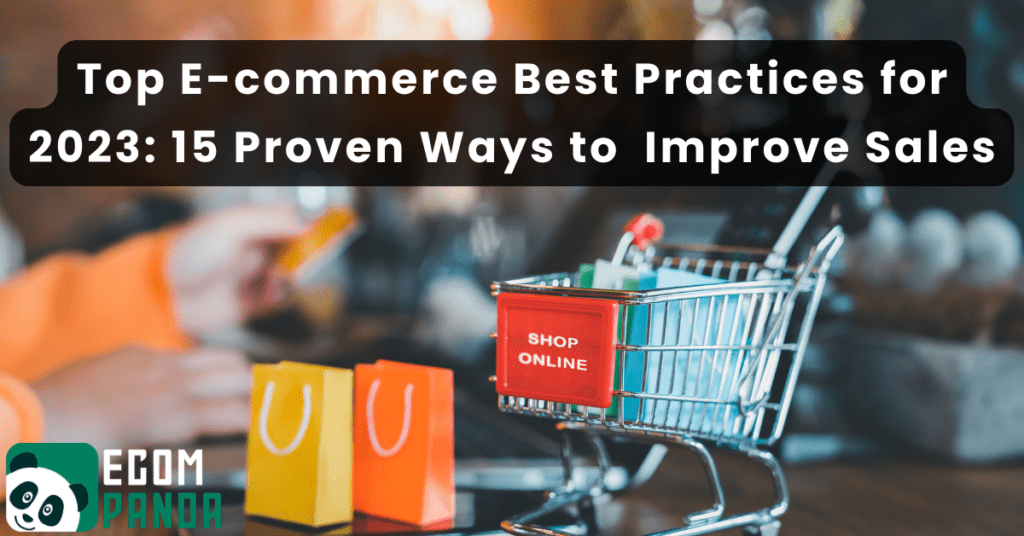
Table of Contents
Understanding E-commerce Practices for 2023
E-commerce has grown tremendously in recent years and continues to evolve, creating a need for businesses to stay current with emerging trends. E-commerce best practices for 2023 focus on leveraging technology and understanding customer behavior to create an effective, personalized shopping experience.
These practices are largely dictated by the rise of AI and data analytics, alongside the continued growth of social commerce and the desire for personalized shopping experiences.
E-commerce best practices have adopted advanced tools like AI-generated content for marketing, customer segmentation strategies, and new platforms for engagement such as social commerce.
The global e-commerce market is projected to reach $6.3 trillion in 2023, indicating the importance of implementing these best practices for successful business operations.
The Evolution of E-commerce Strategies
E-commerce strategies have significantly evolved since their inception. In the past, e-commerce primarily focused on creating an online presence and selling products through a digital platform. However, the rise of digital technology and changing consumer behavior have ushered in new strategies.
Modern e-commerce strategies are characterized by a focus on personalization, social commerce, AI and data analytics, AR/VR technology, subscription services, and ethical shopping. Moreover, businesses are focusing on differentiating their products and services in the highly competitive e-commerce landscape.
E-commerce strategies are no longer about merely selling online. Instead, businesses are focusing on creating personalized shopping experiences, using data analytics and AI to provide tailored product recommendations and targeted advertising.
E-commerce best practices also emphasize establishing strong customer relationships and providing value through services like subscriptions and sustainable shopping options.
Impact of E-commerce Best Practices on Sales
Implementing e-commerce best practices can significantly boost sales. These practices revolve around understanding customer behavior, needs, and preferences, and then tailoring offerings accordingly.
Practices like personalization, AI and data analytics, AR/VR technology, and subscription services aim to enhance the customer shopping experience, leading to increased sales.
E-commerce best practices, such as utilizing AI for personalization, can help businesses stand out in the competitive e-commerce landscape, attract more customers, and consequently increase sales1. Moreover, ethical shopping practices cater to the growing number of consumers who prefer businesses with sustainable practices, potentially driving sales.
Furthermore, e-commerce best practices focusing on social commerce and subscriptions can enhance customer engagement and retention. These practices not only allow businesses to reach a wider audience but also encourage repeat purchases, thereby increasing sales.
In conclusion, businesses need to understand and implement current e-commerce best practices to stay competitive in 2023 and beyond. Leveraging AI and data analytics, creating personalized experiences, and focusing on ethical shopping and customer relationships are key to increasing sales and achieving long-term success in the evolving e-commerce landscape.
15 E-commerce Best Practices to Boost Your Sales
Adopting E-commerce best practices is a surefire way to boost your sales in today’s competitive online marketplace. Firstly, improving your website’s user experience is paramount. This can be achieved through a streamlined UI/UX and a simple navigation system, making it easy for customers to browse and shop.
Secondly, focus on enhancing trust. This can be achieved by displaying trust badges, positive press coverage, and reviews. A valid SSL certificate is also crucial in this regard.
Next, leveraging high-quality, appealing product images is another of the E-commerce best practices. Since customers can’t physically touch the products, vivid and detailed images from multiple angles can help them envision owning the product, thereby increasing conversion rates.
Lastly, use analytics to understand your customers better. This involves identifying purchasing patterns and preferences to tailor your marketing efforts.
In conclusion, employing these E-commerce best practices will not only boost your sales but also ensure a seamless shopping experience for your customers.
Get Rid of Clutter
The Role of Minimalism in E-commerce
In the bustling world of e-commerce, minimalism can be the key to your site’s success. Ebbinghaus’s research on memory, recall, and clutter shows that reducing cognitive load can lead to better customer engagement and conversion.
Applying this to e-commerce best practices, minimalism can help users focus on what’s essential, rather than getting lost in an overwhelming amount of information. By paring down your website to the most crucial elements, you guide your customers towards the key decision-making information. It’s the equivalent of a clean, organized brick-and-mortar store where every product is in its proper place.
Methods to De-Clutter Your Website
To de-clutter your website, start by focusing on core content as mentioned in e-commerce best practices.
- Ensure your product descriptions are concise and engaging, and your images are high-quality and meaningful.
- Limit the use of flashy banners or unnecessary elements that distract users.
- Navigation should be intuitive and straightforward.
- Use clear category divisions and ensure every page is easily accessible.
- Too many options can lead to decision fatigue, so keep your menus clean and simplified.
Also, it’s crucial to design your website with a mobile-first approach. Considering the increasing number of mobile shoppers, ensure your site performs well on smaller screens without clutter.

Make Your Website Trustworthy
Elements of Trust in E-commerce
Trust is a foundational component of e-commerce best practices. Customers want to be assured that their data is safe, their purchases secure, and their overall shopping experience is reliable. In the e-commerce world, trust can be achieved through several elements.
Clear, accurate, and consistent product information is a significant aspect of building trust. The use of high-quality images and video, thorough product descriptions, and accurate customer reviews can also contribute to the trust factor.
Moreover, having a secure website is crucial. Having an SSL certificate (https://) is essential, as it’s an indicator that the site is secure and data transmitted is encrypted.
Building Trust: Key Strategies
To build trust, focus on demonstrating transparency and reliability. Make your business’ contact information clearly visible and easy to find. Also, provide easy access to customer service, such as a live chat function, which can answer customer queries in real-time.
Customer reviews and ratings are crucial trust-building tools. Genuine, unfiltered customer reviews show prospective customers that your business values transparency and is confident in the quality of your products.
Moreover, it’s essential to keep the customer’s data safe. A part of e-commerce best practices is having strong cybersecurity protocols and standards in place, ensuring the customer’s data remains secure.
To succeed in the world of e-commerce, remember the importance of minimizing clutter and fostering trust. By employing these e-commerce best practices, you can streamline the shopping experience and build a loyal customer base.

Use Appealing Images
Importance of Product Imagery in E-commerce
Product images are a pivotal part of e-commerce best practices. An appealing product image has the power to make or break your online sale, given the visual nature of online shopping. A clear, high-quality photo can help overcome one of the biggest hurdles in online sales: the inability of the customer to physically touch and examine the product. The images bridge the gap between the physical and the virtual, providing the customer with a sense of familiarity and confidence to make a purchase.
Tips for Creating Effective Product Images
Here are some practical tips to contemplate.
- To create effective product images, focus on showcasing the product in the best light, literally and metaphorically.
- High resolution is crucial, but it’s not the only aspect to consider.
- Pay attention to lighting, angles, and backgrounds to ensure they enhance rather than detract from the product.
- Include different views and close-ups to highlight key features or quality.
- Incorporating lifestyle images showing the product in use can provide context and inspire potential customers.
Remember, transparency is key; don’t misrepresent your product through overly enhanced or edited images.

Create a Streamlined UI/UX
Role of User Interface and User Experience in E-commerce
In the world of e-commerce, the importance of a streamlined User Interface (UI) and User Experience (UX) cannot be overstated. These elements significantly affect how a user interacts with an e-commerce site.
A well-designed UI/UX can lead to increased customer satisfaction and ultimately drive sales. From finding a product to checking out, every touchpoint a customer has with your site impacts their shopping experience, and by extension, their perception of your brand.
Guidelines for Streamlined UI/UX Design
Following e-commerce best practices, you must aim to deliver an efficient, enjoyable shopping experience through your UI/UX design.
- Keep the layout clean, intuitive, and consistent to help customers easily navigate your site.
- Ensure all elements, including images, buttons, and text, are optimally placed and sized for readability and interaction.
- Speed is vital, so optimize for fast load times and smooth transitions.
- Test and iterate your design on different devices to ensure a seamless shopping experience, regardless of the platform your customer chooses to use.

Keep Navigation Simple
The Need for Easy Navigation in E-commerce
Another critical aspect of e-commerce best practices is the simplicity of navigation. Customers are more likely to abandon their shopping if they struggle to find what they’re looking for. Easy navigation enhances the customer’s experience, allowing them to find their desired product quickly and efficiently, increasing the likelihood of completing a purchase.
Best Practices for Simplifying Navigation
E-commerce best practices recommend a well-organized, hierarchical site structure.
- Make use of clear categories and subcategories and include a search bar for quick access to specific products.
- Breadcrumbs can help users understand their navigation path, and a well-defined menu can guide them through your site.
- Consider the use of filters to refine product lists based on various parameters like price, brand, or reviews.
These e-commerce best practices demand attention to detail in terms of imagery, UI/UX, and navigation. Delivering a seamless and enjoyable shopping experience is key to retaining and attracting customers in a competitive e-commerce landscape.
By implementing these best practices, you can significantly enhance your e-commerce site, increasing user satisfaction and ultimately driving growth and profitability.

Create Engaging Product Demos
Benefits of Product Demos in E-commerce
Engaging product demos are a critical part of e-commerce best practices. They offer an interactive and detailed view of the product, giving potential customers a virtual experience of what they are considering to buy. This can significantly increase the conversion rate, as customers are more likely to purchase when they can visualize the product in action. Furthermore, product demos also reduce the chances of returns as they provide a clear understanding of the product’s features and functionalities.
Effective Strategies for Product Demos
Creating engaging product demos starts with understanding your customer’s needs and pain points. Show not only how the product works but also how it solves the customer’s problem. Make use of high-quality video content, 3D graphics, or augmented reality to enhance the demo experience. Also, keep the demos short, easy to understand, and interesting to hold the customer’s attention.

Opt for the Best Possible Hosting
Importance of Hosting in E-commerce
Hosting plays an essential role in e-commerce best practices. A good hosting provider and domain ensure your e-commerce site is always up and running, provides optimum site speed, and secures your website data.
These factors are key to providing a smooth user experience and building trust with your customers. Any downtime, slow load time, or security breach can lead to lost sales and damage your brand reputation.
Choosing the Right Hosting Provider: Factors to Consider
Choosing the right hosting provider can be overwhelming with numerous factors to consider.
- Start by evaluating your needs based on the size and type of your e-commerce business.
- Look for a provider with strong uptime guarantees, robust security features, and excellent customer support.
- Additionally, consider the scalability of the hosting solution to ensure it can support your business as it grows.

Offer a Range of Filters
Role of Filters in Product Search and Selection
Filters are a crucial element in the e-commerce best practices toolbox. They allow customers to narrow down their product search based on specific criteria such as size, color, price, brand, and more. By providing an efficient way to find the desired product amidst a vast range, filters improve the shopping experience and increase the likelihood of a purchase.
Best Practices for Implementing Filters
Implementing effective filters begins with understanding your customers and their shopping behavior. Provide filters that are most relevant to your product range and customer preferences. Ensure filters are easily visible, intuitive, and responsive. Also, allow for multiple selections within a filter and clear indicators for applied filters.
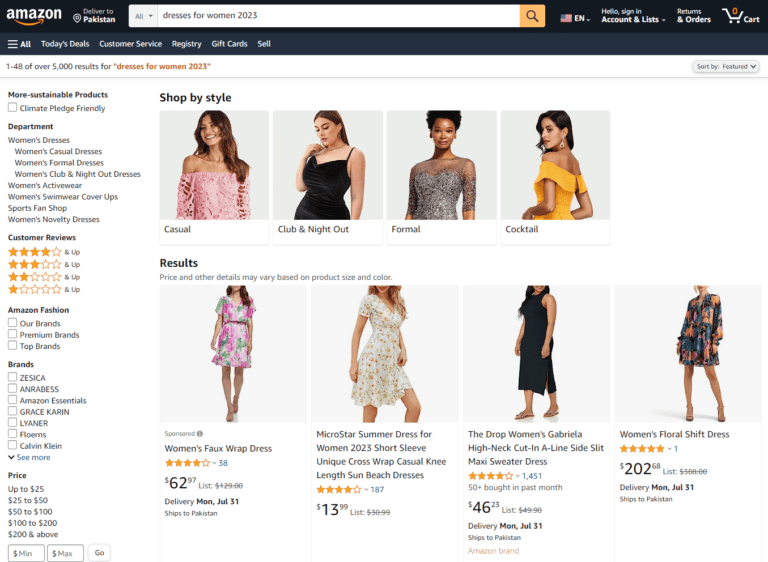
Cover a Range of FAQs
Advantages of a Comprehensive FAQ Section
A comprehensive FAQ section is an important part of e-commerce best practices. It provides a self-help tool for customers to find answers to common questions, saving them time and enhancing their shopping experience. Furthermore, a well-crafted FAQ section can improve your site’s SEO ranking, making it easier for customers to find your site through search engines.
Crafting Effective FAQs
Crafting effective FAQs requires you to think from a customer’s perspective. Include questions about product usage, shipping, returns, and any other relevant aspects of your e-commerce business. Keep the answers concise, clear, and easy to understand. Make sure the FAQ section is easily accessible and organized for easy navigation.
Adhering to e-commerce best practices in creating engaging product demos, choosing the right hosting, offering effective filters, and maintaining a comprehensive FAQ section can greatly enhance your online store’s functionality and user experience.
It’s a continuous process that needs regular monitoring and updates in line with evolving customer needs and technological advancements. By doing so, you can build a successful and sustainable e-commerce business in the long run.
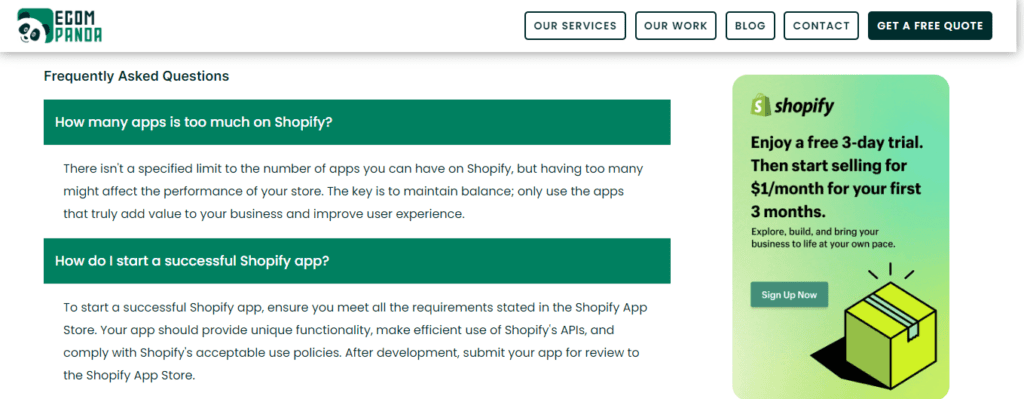
Don’t Force Shoppers to Create an Account
Impact of Forced Account Creation on Shopping Experience
As an e-commerce best practice, it is important to acknowledge that forcing shoppers to create an account can have a negative impact on the overall shopping experience. Account creation can often be a tedious process, requiring shoppers to fill in lengthy registration forms and remember additional login details.
The requirement to sign up for an account could deter potential customers, leading to an increase in cart abandonment rates, and potentially result in a lower conversion rate.
Implementing Guest Checkout: Why and How
Guest checkout is an e-commerce best practice that offers a smoother and more enjoyable purchasing experience for shoppers. It eliminates the hurdles of account creation and login, and allows customers to make purchases more quickly and with fewer barriers.
This can result in higher conversion rates and a lower shopping cart abandonment rate. Furthermore, guest checkouts can provide shoppers with a greater sense of security, as their personal and payment information isn’t saved on the platform. To implement guest checkout, offer it as an alternative to account creation at the start of the checkout process.

Add Quality Product Descriptions
Role of Product Descriptions in Purchase Decisions
Product descriptions play a pivotal role in the purchase decisions of consumers. They provide essential information about the product’s features, benefits, and usage, thereby helping customers understand the value of the product and how it can meet their needs. Detailed, engaging, and persuasive product descriptions can significantly influence a customer’s decision to purchase, making it a crucial e-commerce best practice.
Writing Quality Product Descriptions: Key Strategies
Writing quality product descriptions involves several key strategies.
- Firstly, know your audience and tailor your descriptions to their needs and language style.
- Secondly, highlight the benefits of your products, not just their features.
- Explain how your products can solve problems or improve the customer’s life.
- Use storytelling to engage the reader, and include social proof like customer reviews or ratings.
- Use SEO-friendly language, but avoid jargon and ensure your descriptions are easy to read and understand.
Remember, the aim of a product description is to convince the customer to buy, so make it compelling and persuasive.
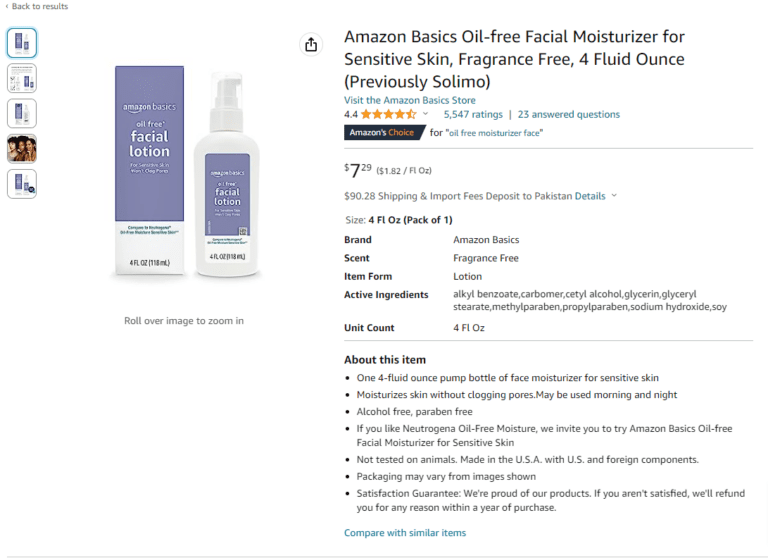
Send Emails for Shopping Cart Abandonment
Understanding Shopping Cart Abandonment
Shopping cart abandonment refers to the phenomenon where customers add products to their online shopping cart, but leave the website without completing the purchase. It is a common issue faced by e-commerce businesses and understanding its causes is crucial. Some of the reasons include unexpected shipping costs, complex checkout process, or requirement to create an account.
Cart Abandonment Emails: Best Practices and Strategies
Addressing shopping cart abandonment is one of the best e-commerce best practices. Cart abandonment emails are a highly effective strategy to recover lost sales. These are automated emails sent to customers who have left items in their cart without purchasing.
Best practices for cart abandonment emails include;
- Sending the email within a few hours of abandonment, making the email personalized, and clearly showcasing the products left in the cart.
- Offering incentives like discounts or free shipping can also encourage customers to complete their purchase.
- It’s also essential to have a clear call-to-action button that directs customers back to their cart.
- Finally, optimize your emails for mobile viewing, as a significant number of shoppers use their mobile devices for online shopping.
Implementing these strategies can help turn potential lost sales into conversions.

Work on Improving Loading Times
Effect of Loading Times on User Experience and Sales
Loading times can greatly impact the user experience and, by extension, sales in E-commerce. When a website loads slowly, it can lead to a decrease in organic traffic, fewer opportunities to turn visitors into customers, and a decrease in search ranking.
A high percentage of shoppers leave a page if it takes longer than three seconds to load, causing your conversion rates to drop. In the realm of E-commerce best practices, improving loading times is crucial for retaining and attracting customers.
Techniques to Improve Loading Times
Several techniques can be used to enhance loading times. Some of these include;
- The optimization of image sizes and scripts, using browser caching, and minimizing HTTP requests.
- Utilizing Content Delivery Network (CDN) to distribute the load of delivering content can also expedite loading times.
- Employing tools like Google’s PageSpeed Insights (PSI) can help identify areas that need improvement and track the impact of these changes on page load times.
As an E-commerce best practice, working on improving loading times can significantly increase sales and improve the user experience.
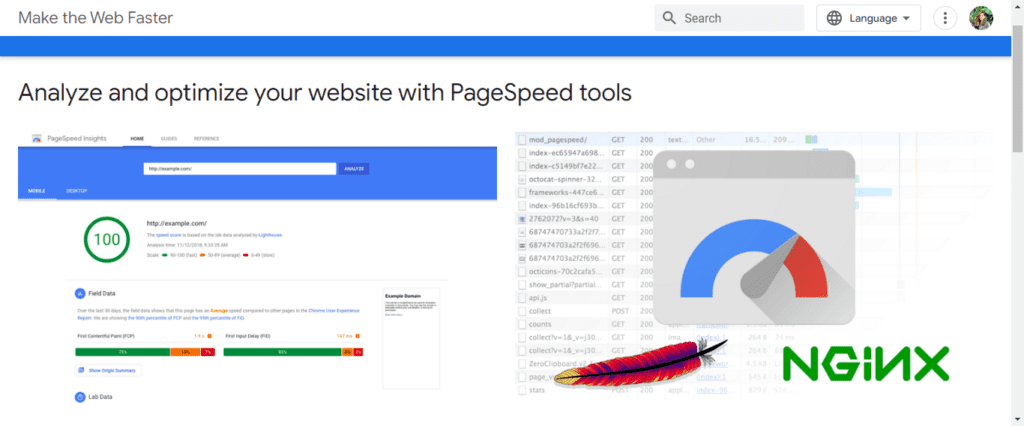
Improve Your Website’s Responsiveness
Importance of Website Responsiveness in E-commerce
Website responsiveness plays a vital role in E-commerce. A responsive website design ensures that your site can adapt to different devices, leading to a better user experience. Website speed optimization, often part of website responsiveness, directly affects your store’s conversion rate and, ultimately, your bottom line.
It’s also worth noting that Google’s search engine algorithms favor websites that perform well across various devices, making this a crucial aspect of E-commerce best practices.
Strategies for Enhancing Website Responsiveness
To enhance website responsiveness, consider implementing techniques such as;
- Designing with a mobile-first approach, using responsive images, and ensuring that all elements of your site are fully functional across all device types.
- Furthermore, optimization of website speed by addressing common factors such as rendering time and the performance of your e-commerce platform can greatly enhance your website’s responsiveness.
This falls directly in line with E-commerce best practices for enhancing user experience and improving sales.

Create Scarcity
Scarcity as a Sales Tactic in E-commerce
Scarcity in E-commerce is a powerful psychological sales tactic that can significantly boost conversions. By creating a sense of urgency (e.g., limited stock or time-bound offers), customers are compelled to make immediate purchasing decisions. This tactic can also enhance the perceived value of your products, making them more appealing to potential customers.
How to Create and Manage Scarcity Effectively
Creating and managing scarcity effectively involves several strategies. These can include limited time offers, showcasing limited stock availability, and creating exclusive products or services.
Flash sales and special promotions can also create a sense of urgency. However, this tactic should be used judiciously to avoid undermining customer trust. As a crucial E-commerce best practice, effectively managing scarcity can lead to increased conversions and higher sales.
In conclusion, working on improving loading times, enhancing website responsiveness, and creating scarcity are all essential E-commerce best practices that can significantly improve the user experience and drive sales. It’s important to continuously evaluate and optimize these elements to ensure you are delivering a seamless and compelling online shopping experience.

Conclusion
Summarizing E-commerce Best Practices for 2023
As we conclude, it’s crucial to underline the e-commerce best practices that have become pivotal in 2023. First, the judicious use of SEO has proven to be more necessary than ever, with an estimated 75% of online shoppers turning to Google for product research prior to making purchases. E-commerce websites need to embrace SEO best practices to stand up to the e-commerce giants, enhancing visibility and conversion rates.
A key aspect of SEO is sharing and structuring product data so it can appear across various Google surfaces, such as Google Search, Images, Lens, Shopping, Business Profile, and Maps. The structured data pairs an attribute with a value (e.g., “color: blue”), making it easier for Google to serve your products for specific search queries.
Moreover, quality product reviews have emerged as a substantial factor in SEO success. Detailed and nuanced reviews not only help improve click-through rates, but they also feed Google rich data, which aids in product recommendation and feature highlighting1.
In terms of website performance, it’s become best practice to use a fast, performant front-end framework. Mobile-friendly pages, HTTPS, optimized images and videos, code minification, and deferring non-critical CSS and JS are among the technical SEO practices crucial to the user experiences.
Future Trends to Watch in E-commerce
Looking ahead, we foresee several emerging trends in the e-commerce landscape. The adoption of headless architecture is rapidly growing, offering numerous benefits beyond performances.
With this, brands can utilize powerful back-end systems like WordPress or Shopify, while optimizing the front-end experience using modern frameworks like Gatsby or Next.js. This means businesses can reap the benefits of dynamic content management while ensuring an optimal user experience.
In addition, we’re likely to see more sophisticated utilization of the Google Merchant Center, allowing retailers to process product feeds into Google-friendly structured data. This will likely lead to more tailored and specific product serving based on user search queries.
Finally, as e-commerce continues to grow, businesses will need to focus more on customer acquisition and retention. SEO will play an even larger role in this, with refined SEO best practices aiding in business growth.
These e-commerce best practices and upcoming trends showcase the importance of staying updated in this ever-evolving digital commerce landscape. With proper application of these strategies, businesses can ensure visibility, growth, and longevity in the dynamic world of e-commerce.
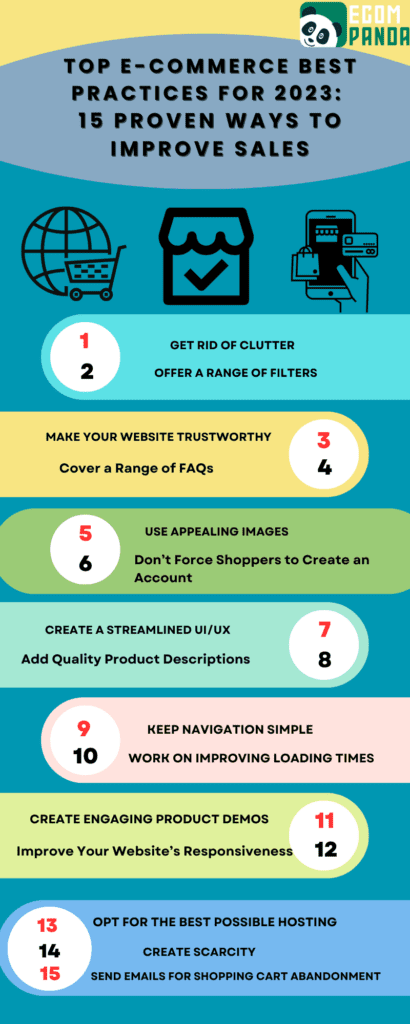
Frequently Asked Questions
What are the best practices in e-commerce?
E-commerce best practices include offering a user-friendly experience, minimizing website clutter, incorporating trustworthy elements like badges and customer testimonials, optimizing for mobile, and utilizing high-quality images. Consistent follow-up, hosting on reliable platforms, and maintaining speedy loading times also contribute to e-commerce success.
What are the 5 most important things to know before starting an e-commerce business?
Before launching an e-commerce business, it's crucial to understand
1) the importance of a trustworthy and user-friendly website
2) the need for high-quality product images
3) the power of user reviews and testimonials
4) the role of seamless navigation,
5) the value of a streamlined UI/UX design to increase user engagement and ultimately, sales.
What are the 3 most important things that you can do to make your e-commerce site visible on the Web?
To enhance your e-commerce site's visibility on the web;
1) focus on SEO to boost your website's rankings in search engine results
2) make use of social media platforms for promotion and customer engagement
3) optimize for mobile since many customers access e-commerce sites via smartphones.
This complements the larger theme of adhering to e-commerce best practices.
What are the 4 traditional types of e-commerce?
The four traditional types of e-commerce include:
1) Business to Business (B2B), where goods and services are sold from one company to another.
2) Business to Consumer (B2C), where a business sells directly to a customer.
3) Consumer to Consumer (C2C), where consumers sell directly to other consumers via online marketplaces.
4) Consumer to Business (C2B), where individuals sell goods or services to businesses.
How do I make my e-commerce store successful?
To make your e-commerce store successful, adhere to e-commerce best practices.
- Create a user-friendly website with a simple navigation system.
- Provide high-quality product images and descriptions, optimize for mobile devices.
- Use SEO strategies for visibility, and offer excellent customer service.
These e-commerce best practices enhance customer trust, user experience, and ultimately, conversions.







